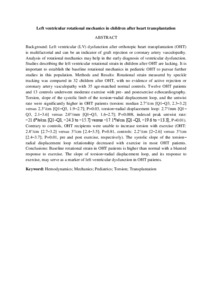Citation
Nawaytou, Hythem M. and Yubbu, Putri and Montero, Andrea E. and Nandi, Deipanjan and O’Connor, Matthew J. and Shaddy, Robert E. and Banerjee, Anirban
(2016)
Left ventricular rotational mechanics in children after heart transplantation.
Circulation Cardiovascular Imaging, 9 (9).
pp. 1-15.
ISSN 1941-9651; ESSN: 1942-0080
Abstract
Background: Left ventricular (LV) dysfunction after orthotopic heart transplantation (OHT) is multifactorial and can be an indicator of graft rejection or coronary artery vasculopathy. Analysis of rotational mechanics may help in the early diagnosis of ventricular dysfunction. Studies describing the left ventricular rotational strain in children after OHT are lacking. It is important to establish the baseline rotational mechanics in pediatric OHT to pursue further studies in this population. Methods and Results: Rotational strain measured by speckle tracking was compared in 32 children after OHT, with no evidence of active rejection or coronary artery vasculopathy with 35 age-matched normal controls. Twelve OHT patients and 13 controls underwent moderate exercise with pre- and postexercise echocardiography. Torsion, slope of the systolic limb of the torsion–radial displacement loop, and the untwist rate were significantly higher in OHT patients (torsion: median 2.7°/cm [Q1–Q3, 2.3–3.2] versus 2.3°/cm [Q1–Q3, 1.9–2.7]; P=0.03, torsion–radial displacement loop: 2.7°/mm [Q1–Q3, 2.1–3.6] versus 2.0°/mm [Q1–Q3, 1.6–2.7]; P=0.008, indexed peak untwist rate: −21.6°/s/cm [Q1–Q3, −24.3 to −15.7] versus −17.1°/s/cm [Q1–Q3, −19.6 to −13.3]; P=0.01). Contrary to controls, OHT recipients were unable to increase torsion with exercise (OHT: 2.8°/cm [2.7–3.2] versus 3°/cm [2.4–3.5]; P=0.81, controls: 2.2°/cm [2–2.6] versus 3°/cm [2.4–3.7]; P=0.01, pre and post exercise, respectively). The systolic slope of the torsion–radial displacement loop relationship decreased with exercise in most OHT patients. Conclusions: Baseline rotational strain in OHT patients is higher than normal with a blunted response to exercise. The slope of torsion–radial displacement loop, and its response to exercise, may serve as a marker of left ventricular dysfunction in OHT patients.
Download File
![[img]](http://psasir.upm.edu.my/54705/1.hassmallThumbnailVersion/Left%20ventricular%20rotational%20mechanics%20in%20children%20after%20heart%20transplantation.pdf)  Preview |
|
Text
Left ventricular rotational mechanics in children after heart transplantation.pdf
Download (75kB)
| Preview
|
|
Additional Metadata
Actions (login required)
 |
View Item |

